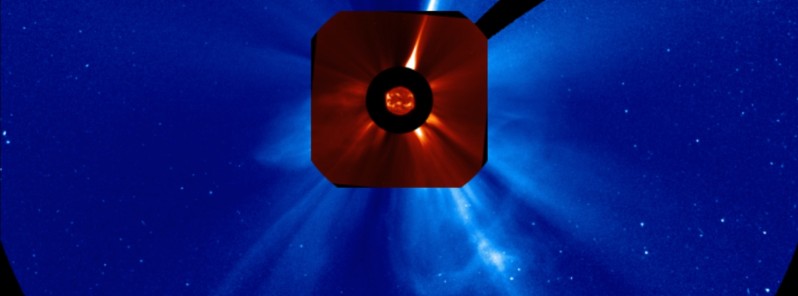The period of January 9 to 15, 2023, was marked by intense solar activity, with numerous M and X-class flares being observed. The largest event of the period was an X1.9 flare on January 9, followed by an X1.0 on January 10. There were a total of 2 X-flares and 25 M-flares during the period but only two Earth-directed CMEs were observed from this flurry of activity.
The largest event of the period was an X1.9/3b flare (R3-Strong) from Region 3184 at 09:18 UTC on January 9.
This region also produced multiple M-class flares, including:
- M1.1/Sf at 01:02 UTC on January 9
- M1.0/Sf at 02:16 UTC on January 10
- M1.0 at 11:08 UTC on January 10
- M1.2 at 17:48 UTC on January 10
- M5.6/1b at 01:56 UTC on January 11, with an associated Tenflare and a Type II radio sweep (628 km/s) at 01:53 UTC on January 11
The next largest event was an X1.0/2b flare (R3-Strong) with an associated Tenflare from Region 3186 at 22:47 UTC on January 10, which also produced multiple M-class flares:
- M5.1/Sf at 00:16 UTC on January 10
- M1.3 at 17:28 UTC on January 10
- M2.4/1f at 00:59 UTC on January 11
- M3.1/Sn at 08:33 UTC on January 11
- M1.1 at 06:18 UTC on January 12
- M1.5 at 06:46 UTC on January 12
- M1.4/1n at 02:59 UTC on January 13
Region 3181 also produced multiple M-class flares:
- M2.1/1n at 09:01 UTC on January 9
- M1.0 at 13:22 UTC on January 9
- M2.6/2n at 02:41 UTC on January 10
- M1.3/Sf at 06:09 UTC on January 11
- M1.2/Sf at 11:28 UTC on January 12
- M3.9/Sn at 10:15 UTC on January 13, with an associated Type II radio sweep (381 km/s) at 10:20 UTC.
Region 3182 produced:
- M1.0 flare at 14:57 UTC on December 12
- M1.2 flare at 19:13 UTC on December 12
- M3.5 flare at 21:21 UTC on January 14
- and an M4.6 flare at 21:00 UTC on January 14.
Region 3191 produced an M1.3/Sf flare at 02:09 UTC on January 14 and an M6.0/Sf flare at 03:42 UTC on January 15, with an associated Type II radio sweep with an estimated velocity of 223 km/s at 03:10 UTC on January 15.
Region 3190 contributed an M4.8/2b flare at 14:30 UTC on January 15.
There were a total of 2 X-flares and 25 M-flares during the period.
Interestingly, there were only two Earth-directed CMEs observed from this flurry of activity.1
The first CME was associated with the M5.6/1b flare at 01:56 UTC on January 11, from Region 3184, and the second CME was associated with the M4.6 flare at 21:00 UTC on January 14, from Region 3182.
Proton activity was relatively low during the period, with the 10 MeV proton flux reaching a peak of 4.51 pfu on January 13. This enhancement followed an observed CME in LASCO/C2 imagery with a source from around the west limb.
The greater than 2 MeV electron flux at geosynchronous orbit was at moderate levels throughout the reporting period.
Geomagnetic field activity was primarily at quiet to G1 – Minor storm levels, with G1 conditions observed on January 15 in response to a CME that left the sun on January 11.
Total field strength increased to a peak of 14 nT and Bz dropped as low as -10 nT, with several hours of sustained, negative Bz. Solar wind speed during the transient rose to 524 km/sec.
Active conditions were observed on January 13 and 14 in response to negative-polarity coronal hole high speed stream (CH HSS) influence.
During the remainder of the period, quiet to unsettled levels were observed.
Forecast of solar and geomagnetic activity: January 16 – February 11, 2023
Solar activity is likely to remain at moderate to high levels throughout the outlook period of January 16 – February 11, 2023. This is due to the presence of numerous existing and returning M and X-class flare-producing regions on the Sun’s surface.
There’s a slight chance for proton events at geosynchronous orbit during the outlook period, due to the magnetic complexity and flare history of the abundant sunspot groups.
The greater than 2 MeV electron flux at geosynchronous orbit is expected to be at high levels from January 20 – 30, 2023 in response to recurrent CH HSS influence. The remainder of the outlook period is expected to be at moderate levels.
The geomagnetic field activity is also expected to range from quiet to G1 – Minor geomagnetic storm conditions.
G1 conditions are anticipated on January 26, with active conditions likely on January 19 and February 9, and unsettled conditions likely on January 16, 18, 20-22, 25, 27-28, and February 1-2, 7-8, and 10.
This increased geomagnetic activity is in response to multiple, recurrent CH HSSs.
The remainder of the outlook period is expected to be mostly quiet.
1 Weekly Highlights and Forecasts – Prepared by the US Dept. of Commerce, NOAA, Space Weather Prediction Center – Issued at 04:53 UTC on January 16, 2023

